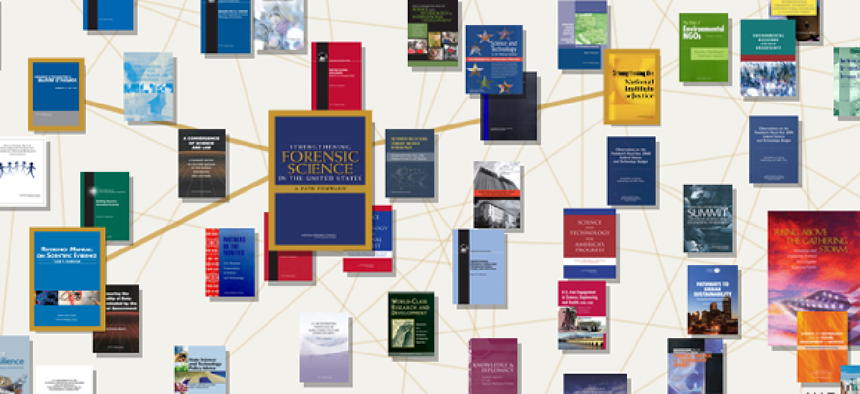Picture this: AcademyScope visualizes research library


Connecting state and local government leaders
The National Academies Press’s AcademyScope makes it easy to browse related research and to download reports in PDF format.
Computers are really good at handling data. People? Not so much.
That’s why designing effective tools for accessing the data sets is so important. A team at the National Academies Press has developed a unique interface for exploring its library of more than 5,400 research reports from the National Academy of Sciences, the National Academy of Engineering, the Institute of Medicine and the National Research Council.
The AcademyScope web application, which went live just last month, offers an initial display of a swarm of report covers, indicating the number of times each has been downloaded, a figure that is updated in real time. When users click on a title, the cover appears in a panel on the right-hand side, along with a description of the report. Related titles are displayed at the bottom of the panel, and links are available for downloading the report or viewing it online.
Among the swarm of covers are lines linking many of the reports. Each line represents a judgment that the two reports are linked by having similar content.
According to Alphonse MacDonald, NAP’s director of marketing and technology, when a new report is available it is converted into a PDF file. Apache Lucene is then used to index the full text of the upload and to create an index that is integrated with the master index. “We compare the full-text index of each book against the others to determine which books are related to each other,” said MacDonald. “We run that engine every night.”
Actually, the AcademyScope web application was modeled after a version that had been running on a 55-inch touchscreen display in the lobby of the NAP. Juan Thomassie, an independent contractor, was hired to convert the standalone application to a web application.
“Because it was a standalone kiosk and not connected to the Internet you couldn’t take the next logical step, which was to actually get to the publications,” said Thomassie.
The job was a challenge, he said. “They wanted to make it with all the bells and whistles of the kiosk but also into something that would work with Windows and pretty much any browser,” he said. “Performance would be an issue on an iPad, and there’s no way to make this work on phones just because there is so much data and so much intensive display memory needed to show all of the various images.”
Thomassie built the app using JavaScript D3 and chose BackBone to build the pages and query the data.
There are a few things that could be done to improve AcademyScope. For starters, adding a keyword search tool would be nice. As it is, browsing is the only way to navigate to titles.
MacDonald said the team has plans for Phase 2 of AcademyScope, including being able to show geographic locations to which reports are downloaded. MacDonald said that when users can dig down into such data, they see some surprising things. For example, “Our agriculture reports have a great interest in Latin America and Africa. For those, we see about 40 percent of the downloads coming from the United States, and Brazil and Argentina come closely behind.”
According to Stephen Mautner, executive editor of NAP, AcademyScope has already had a major impact, in part because it makes it so easy to download reports in PDF format. “I wouldn’t say we were kicking and screaming when we finally ended up doing that,” he said, “but it was not a comfortable process for us because we made lots of money on selling our books. We still make a considerable amount, but hard-copy sales have diminished.”
Mautner added that the American Association of University Presses has shown interest in implementing the technology. His boss, as it happens, is serving a one-year term as president of the association. “She is reporting back to us that that organization is intrigued and very seriously entertaining the idea of adapting this technology to all the publications of University presses nationwide,” Mautner said.
“There are interesting synergies and connections among those lists of books that this kind of thing could reveal in interesting ways. It shows patterns and relationships that you didn’t see before. So we are actively imagining ways in which we can build this out.”
Editor's note: This article was changed Dec. 3 to correct the JavaScript version.



